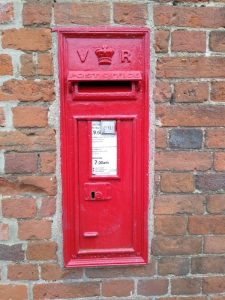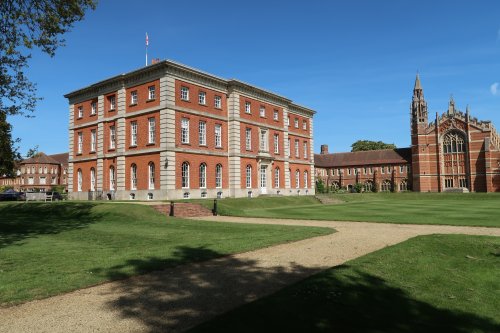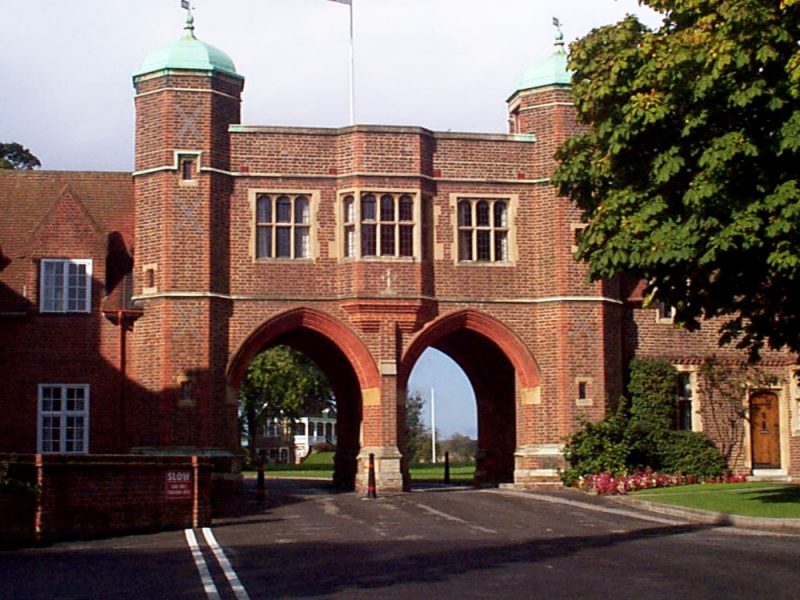All the Radley History Club books referred to below are available to buy from the Publications section of this website or from Radley Village Shop.
Click on an image to see a larger version, which will open in a new window.
The Bowyer Arms opened in the 1850s – after the railway came to Radley but before the station was built.
The pub sign depicts Sir George Bowyer (1810-1883).
Morland, the former Abingdon brewers, bought the pub in 1889, having previously leased it from the Bowyer Estate. It is now owned by Greene King.
2 Radley Station

Reproduced with permission from Oxfordshire County Council – Oxfordshire History Centre
Although the Didcot to Oxford line opened in 1844 and the branch line to Abingdon (the ‘Bunk’) in 1856, Radley Station wasn’t built until 1873. Until the late 1980s, the main access to the station was from the Lower Radley side; now access is only off Foxborough Road next to the pub. The bunk passenger service, which ended in 1963, went from a platform adjourning the Oxford one. The station buildings are long since gone and the station is now unmanned.
Don’t forget to look at the information board about the station’s history on the railings near the ticket machine.
For more about the station’s history see the Radley History Club book, Radley People & the Railway 1843–2013
This large house was built by the Great Western Railway at the end of the 19th century for the stationmaster and his family to live in. The 1891 Census records the Radley stationmaster, Charles Ambridge, as living at ‘No. 38 Radley’ with his family: Charles worked for the Great Western Railway from 1854 until his retirement in June 1897. The 1901 Census records his successor as stationmaster, William Parkins, as living with his family at Station House (next on the census enumerator’s list to the Bowyer Arms).
Station House is now a private residence.
VR stands for Victoria Regina and so this post box dates from the reign of Queen Victoria (1837-1901). It’s built into the wall of 89 Church Road, one of the dwellings created from a former Church Farm barn by Radley College for staff housing. In the late 19th century Radley’s Post Office was housed in a thatched cottage (since demolished) nearby on the corner of Church Road and Whites Lane.
Roadside post boxes appeared in Britain in response to the 1840 postal reform which created a system of universal affordable postage. Post boxes fitted into walls first appeared in 1857 to provide cheaper, smaller capacity boxes for small towns and rural areas. Several design improvements were made over the next few decades. The name ‘W.T. Allen & Company’ stamped at the bottom of the Radley VR wall box tells us it was made after 1881, the year the Royal Mail contract for manufacturing wall post boxes passed to this company. The Allen boxes have the royal cipher and crown at the top with the words ‘POST OFFICE’ on the hood; the collection plate is mounted in beading on the door, with provision for a ‘NEXT COLLECTION’ tablet in the top right-hand corner. The box’s dimensions indicate it’s a Type C size wall box.
5 School House
This photograph was probably taken in the 1930s.
Reproduced with permission from Oxfordshire County Council – Oxfordshire History Centre
The precise age of this timber-framed house is uncertain. There is evidence that it shared a chimney with a previous building on the site of the Victorian Old School Building (see below) which the house adjoins.
The School House was the home of successive headteachers until the retirement of Miss Marie Cross in 1974.
Today it is managed by a church trust and is let out.
6 Radley Church of England Primary School
The 1872 building, a replacement for an unsatisfactory earlier school building, was built on land leased to the vicar and churchwardens by Sir George Bowyer (1810-1883). It was extended in 1892 to provide a second classroom. In 1897 Sir George’s sister, Mary, gave the land to the vicar and churchwardens.
Today the Old School Building is used as a resources room while the classrooms are in a separate building constructed in the late 1950s which was extended in the 1960s and again in 2008.
The school’s history is detailed in the Radley History Club book, The History of Radley C E Primary School.
7 Radley Vicarage
The photograph features on one of the series of Radley postcards on sale at Radley Village Shop.
The original timber-framed, wattle-and-daub building was extended on the north side in the 17th century. In 1869 it was linked by a corridor to a new brick building paid for by Radley College to provide extra space for the vicar and the College. The link to the Victorian building (now called Gore House after Charles Gore, a former vicar at Radley who was a founder of the Community of the Resurrection) was removed during a major renovation of the vicarage in 1989/1990.
More about the vicarage can be found in The Story of a Village Church: St James the Great, Radley published by Radley History Club.
The vault lies to the south side of the chancel and was accessed via a trap door in the chancel under the choir stalls. It was commissioned by Sir George Stonhouse (1603-1675); Sir George and all subsequent Stonhouse lords of the manor are buried there, a tradition continued by their successors, the Bowyers, up to Sir George Bowyer (1810-1883). His younger brother, Sir William, is remembered in a memorial in the chancel, while his youngest brother, Sir Henry George, and his nephew Sir George Henry are buried in the churchyard.
More about the burials at Radley Church can be found in The Story of a Village Church: St James the Great, Radley published by Radley History Club. Details of the Stonhouse and Bowyer families are given in the Club’s book, Radley Manor and Village: a thousand year story.
No inscription can be seen on the tomb today which may be the last resting place of one or both of the two Royalist officers buried at Radley in July 1643: Capt. Thomas Gylburke under ‘Eellswell Lansford’s regiment’ [probably Sir Thomas Lunsford of the King’s Army] and Capt. Ltn. Umphrey Baines ‘under Colonel Bellosis’ [probably Colonel John Bellasis, also spelt Belasyse or Bellasyse]. The mortality rate in the village in 1643 was very high, most likely due to deaths from the ‘camp fever’ rampant in Oxford and the surrounding area at a time when the city was King Charles’ main base.
Historic England describes this Grade II listed tomb as: “C17. Limestone. Central recessed moulded panel with worn cherub’s head flanked by 2 panels of relief-carved Tudor roses set within recessed roundels: similar roundels to sides and rear.”
Radley is part of the Benefice of Radley, Sunningwell and Kennington. The church, dedicated to the apostle St James the Great, is probably the oldest surviving building in the village. Its structure has evolved over the centuries, with its earliest parts dating from about 1300. Significant additions and changes have been made over the years. The south transept is thought to date from the 14th century and the tower, nave and south aisle from the 15th century; the porch was added in 1870s. There is no evidence that there was ever a north transept and aisle.
A major restoration took place in 1902. More recently, significant work was needed in 2008/2009 following the discovery of death watch beetle.
More about the church can be found in The Story of a Village Church: St James the Great, Radley published by Radley History Club. A further publication, Faith and Heraldry, describes the church’s stained glass and its history.
This independent boys’ boarding school was founded in 1847 by Revd William Sewell and Revd Robert Corbet Singleton as St Peter’s College. Having initially leased Radley Hall and its grounds, the College bought the site in 1889 when most of the Bowyer estate was put up for sale; Josephine Dockar-Drysdale of nearby Wick Hall bought most of the lots and immediately sold Radley Hall and its grounds to Radley College.
The architects employed by Sir John Stonhouse (1672-1733) to build Radley Hall in the 1720s were the popular Oxford designer/builder, William Townesend and his partner Bartholomew Peisley. By the 1760s its grounds consisted of enclosed parkland (with a lake and deer) known as the ‘Great Park’; an account book belonging to Lancelot ‘Capability’ Brown shows that, although this fashionable landscape gardener was paid £672 in the early 1770s by Sir William Stonhouse (c.1714-1780), the extent of his work at Radley Hall is uncertain.
For more about Radley Hall and its grounds, see Chapter 5 of the Radley History Club book, Radley Manor and Village: a thousand year story.
Today Radley College has an impressive array of buildings, including the former Radley Hall now known as ‘The Mansion’, and is a significant landowner in the area.
12 Memorial Arch
This photograph features on one of the series of Radley postcards on sale at Radley Village Shop.
The Memorial Arch was designed by Sir Thomas Jackson. The foundation stone was laid in 1921 and the memorial was opened by Field-Marshal Sir William Robertson on 31 May 1922. The outer wall of the right-hand arch as you come up the drive is engraved with the name and regiment of every World War One casualty known by 1919; ‘masters’ and ‘servants’ are remembered on separate plaques on the central arch facing this list. The outer wall of the left-hand arch is engraved with the names of all former pupils, masters and servants who died in World War Two.
More information about the war memorials at Radley College is available in its archives.
The soil in north Radley is particularly suited to the growth of hardwood trees such as oak. This venerable tree in the grounds of Radley College has a girth of 28 feet (8.5 metres). Its age is uncertain but it is thought to be more than 300 years old and thus was already here when Sir John Stonhouse built Radley Hall (now the Mansion) in the 1720s. It is in decline compared with a photograph of it taken by the famous Oxford photographer, Henry Taunt, in 1878.
Back to More about Radley and its heritage
More information about points of interest (14-24) on the walk from the pub to the river











